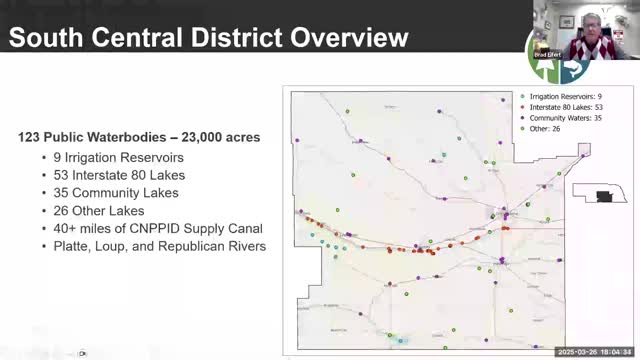Nebraska irrigation reservoirs offer diverse recreational fishing opportunities
May 23, 2025 | Nebraska Game and Parks Commission (NGPC), State Agencies, Organizations, Executive, Nebraska
This article was created by AI summarizing key points discussed. AI makes mistakes, so for full details and context, please refer to the video of the full meeting. Please report any errors so we can fix them. Report an error »

The Nebraska South-Central District Fisheries Meeting held on May 23, 2025, highlighted the region's diverse aquatic resources and the ongoing efforts to enhance fishing opportunities. The meeting, organized by the Nebraska Game and Parks Commission (NGPC), focused on the management of various lakes and reservoirs that play a crucial role in both irrigation and recreation.
The district boasts a significant number of large irrigation reservoirs, with notable mentions including Harlan Reservoir, the second largest in the state, and several others like Sherman and Davis Creek. These water bodies not only serve agricultural needs but also provide ample recreational opportunities for fishing and other water activities. Harlan Reservoir, covering 13,500 acres, is particularly important for local communities, offering a space for families to engage in fishing and outdoor recreation.
In addition to the major reservoirs, the district features over 35 community lakes, ensuring that nearly every town has access to fishing. The meeting emphasized the importance of these lakes in introducing children to fishing, fostering a connection to nature and outdoor activities. The presence of the Central Nebraska Public Power and Irrigation Supply Canal also adds unique fishing opportunities, particularly for species like flathead catfish and sauger.
The meeting also introduced new personnel in the fisheries management team, including two biologists, Colton Curtis and Tyler Bennett, who are expected to contribute significantly to ongoing projects. Their involvement, alongside experienced staff like Alex Engel, who transitioned to a role focusing on irrigation reservoir research, reflects the commitment to effective fisheries management despite a small team size.
The discussions at the meeting underscored the importance of maintaining and enhancing the region's fishing resources, which not only support local ecosystems but also contribute to the community's recreational and economic activities. As the NGPC continues to manage these vital resources, the focus remains on ensuring sustainable fishing practices and improving access for residents and visitors alike.
The district boasts a significant number of large irrigation reservoirs, with notable mentions including Harlan Reservoir, the second largest in the state, and several others like Sherman and Davis Creek. These water bodies not only serve agricultural needs but also provide ample recreational opportunities for fishing and other water activities. Harlan Reservoir, covering 13,500 acres, is particularly important for local communities, offering a space for families to engage in fishing and outdoor recreation.
In addition to the major reservoirs, the district features over 35 community lakes, ensuring that nearly every town has access to fishing. The meeting emphasized the importance of these lakes in introducing children to fishing, fostering a connection to nature and outdoor activities. The presence of the Central Nebraska Public Power and Irrigation Supply Canal also adds unique fishing opportunities, particularly for species like flathead catfish and sauger.
The meeting also introduced new personnel in the fisheries management team, including two biologists, Colton Curtis and Tyler Bennett, who are expected to contribute significantly to ongoing projects. Their involvement, alongside experienced staff like Alex Engel, who transitioned to a role focusing on irrigation reservoir research, reflects the commitment to effective fisheries management despite a small team size.
The discussions at the meeting underscored the importance of maintaining and enhancing the region's fishing resources, which not only support local ecosystems but also contribute to the community's recreational and economic activities. As the NGPC continues to manage these vital resources, the focus remains on ensuring sustainable fishing practices and improving access for residents and visitors alike.
View full meeting
This article is based on a recent meeting—watch the full video and explore the complete transcript for deeper insights into the discussion.
View full meeting
